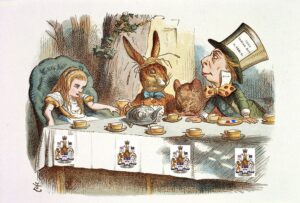Opinion: A Mad Hatter’s tea party: The Indian Act, enfranchisement and registration in the 21st Century

By Karl Hele
A late July ruling by the Quebec Superior Court has removed another asterisk from section 6 of the Indian Act. Simply, the Honourable Babak Barin ruled that section 108 (1), subsequently section 109, of the 1952 through 1985 Indian Act, did not allow for the voluntary enfranchisement of unmarried Indian women. He determined that the Indian Registrar “erred in law” when it denied my daughter’s application for registration based on my mother’s 1965 voluntary enfranchisement. This ruling opens the possibility for other unmarried Indian women who voluntarily enfranchised under sections 108 or 109 to have it ‘undone’.
The arguments made by my representatives rested on the fact that section 108(1) did not allow for unmarried Indian women to voluntarily enfranchise. We maintained that the context of the words as well as the male-centric nature of the 1952 Indian Act clearly intended to exclude unmarried women. The Attorney General of Canada; however, disagreed, maintaining that the intent of the government was to extend enfranchisement to “all Indians” which meant section 108(1) needed to be read as gender-neutral to include unmarried women. Such a reading, we contended and the judge agreed, would render an absurdity into section 108(1), which would produce contrary results to the intent of the Indian Act’s wording that focussed on men and women’s relationships to men.
The ruling also added that enfranchisement was never a right. Instead, it was seen as a privilege, historically, by Canadian society. For First Nations, according to Justice Barin, it was our right to resist and refuse enfranchisement.
In his ruling, Justice Barin also offered his opinion regarding how the courts in hearing cases concerning enfranchisement must take into consideration its repeal in 1985. According to the ruling, the Registrar in denying my daughter’s application, “in a way required the Indigenous peoples of Canada and Canadian society at large to continue to assume the unfortunate consequences of an undesired past.” This highlights the fact that the Indian Act amendments in 1985, 2011, 2016, and 2019, which created and tweaked section 6, reinforced and relied upon past enfranchisement policies from 1869 to 1985 in one way or another. For myself and daughter, our solicitors and Aamjiwnaang First Nation, the intervener, this is a historical hangover. Justice Barin appears to agree with this assessment.
In the end, Justice Barin based his ruling on several factors. First was a set of rules that guides the interpretation of statutes. Distilled, the rule states that statutes are to be read and understood in plain language; meanings that can be arrived at by a reasonable reading. Thus, section 108(1) cannot be reasonably read or interpreted to include unmarried Indian women. Second, he determined that had the legislators in 1952 wanted to include unmarried women in section 108(1), they would have. This determination was based on documents of the debates concerning the 1952 changes, explicit wording of previous Indian Act’s, and the failure to change the wording of section 108 when the government undertook a tweaking of the Indian Act in 1956 to clean up errors and wording. Simply, “the legislature says what it means and means what it says.” Third, Justice Barin determined based on the contemporary Supreme Court of Canada decisions that the statute must be read narrowly, in this circumstance, to protect the rights of Indigenous people. Simply, the section did not include unmarried women; therefore, it cannot be read broadly to include unmarried women. Fourth, section 108(1) must be read in the “light of the current societal, political and legal context.” For Justice Barin, rendering a decision solely based on “facts that were relevant close to seventy years ago does not demonstrate historical sensitivity or respect for the special status of Aboriginal peoples … In the spirit of justice, it should be reclothed and rejuvenated by an interpretation conforming to the spirit of the time in which it is being applied.” Since enfranchisement was abolished in 1985, contemporary Canadian courts should not be required to uphold dubious enfranchisement rulings. To do so would be “nonsensical”. Finally, Justice Barin offered a few words regarding Aamjiwnaang First Nation’s raising of reconciliation in its intervener submission. Based on the written decision, it is apparent that the entire judgement is about reconciliation, as well as justice for my child, other voluntarily enfranchised women, and their descendants.
At the time of writing, it is unclear if the Crown will appeal the decision. It is my sincere hope that the Crown, based on reading Justice Barin’s ruling, will not seek to appeal. Regardless, in issuing the ruling on July 31, 2020, Justice Barin presented my daughter with a wonderful decision right before her ninth birthday. It is a ruling that demonstrates that Canadian Indian policies, the Indian Act, and Crown arguments defending it are really akin to the Mad Hatters’ tea party in Alice in Wonderland. Thankfully, Justice Barin found his way through the rabbit hole while crafting a ruling that will serve others whose female ancestors “voluntarily” enfranchised.
Update: The Crown has stated that it will not appeal the ruling. Descendants of women who were voluntarily enfranchised between 1951/2 and 1985 should read this decision and demand that Indian registrar correct its erroneous decision.


